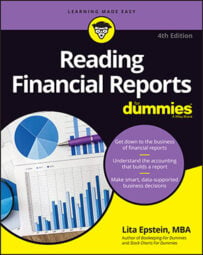The financial reporting profit number you hear discussed most often in the news is the price/earnings ratio, or the P/E ratio. Basically, the P/E ratio looks at the price of the stock versus its earnings.
For example, a P/E ratio of 10 means that, for every $1 in company earnings per share, people are willing to pay $10 per share to buy the stock. If the P/E is 20, then people are willing to pay $20 per share for each $1 of company earnings.
Why are people willing to pay more per dollar of earnings on some stock? Because the people who buy the more expensive stock believe the stock has greater potential for growth. This ratio is used when valuing stocks and is one of the oldest measurements in the world of stock exchanges.
On its own, the P/E ratio means little, but as part of an overall evaluation of a company, the P/E ratio helps you interpret earnings results. Never make a decision on whether to buy or sell a stock based solely on the P/E ratio. Nonetheless, a negative P/E or a P/E of zero is a major trouble sign, indicating that a company isn't profitable.
How to figure out earnings per share
Earnings per share represents the amount of income a company earns per share of stock on the stock market. The firm calculates the earnings per share (EPS) by dividing the total earnings by the number of shares outstanding.
Companies often use a weighted average of the number of shares outstanding during the reporting period because the number of shares outstanding can change as the company sells new shares to outside investors or company employees. In addition, companies sometimes buy back shares from existing shareholders, reducing the number of shares available to the general public.
A weighted average is calculated by totaling the number of shares available during a certain period of time and dividing that number by the number of periods included. For example, if the weighted average is based on a monthly average, the number of shares outstanding on the stock market at the end of each month is totaled and divided by 12 to find the weighted average.
This calculation can also be done with a weekly or daily figure. If weekly stock totals are used, the total of these periods is divided by 52. If daily numbers are used, the total is divided by 365.
How to calculate the P/E ratio
To get the P/E ratio, divide the market value per share of stock by earnings per share of stock:
Market value per share of stock ÷ Earnings per share of stock = P/E ratio
Many websites help you find the market value per share of stock. Yahoo! Finance is great for easily finding historical stock data.
The P/E formula comes in three flavors, which vary according to how earnings per share is calculated: trailing, current, and forward earnings.
Trailing P/E: You calculate a trailing P/E by using earnings per share from the last four quarters, or 12 months of earnings. This number gives you a view of a company's earnings ratios based on accurate historical data.
Leading or projected P/Es: The other two types of P/E ratios are calculated using analysts’ expectations, so they're sometimes called leading or projected P/Es.
The current P/E ratio is calculated using earnings that analysts expect during the current year.
A forward P/E ratio is based on analysts’ projections for the next year.
Any P/E ratio that uses future projected results is only as good as the analyst making those projections. So be careful when you see the terms leading, projected, current, or forward P/E.
Any type of P/E ratio is just one of many profitability ratios to consider. This ratio gives you a good idea of what the public is willing to pay per share of stock based on the company's historical earnings (trailing P/E) or what the analysts project you can consider paying per share of stock based on future earnings (current P/E or forward P/E).
It gives you no guarantee of what the company will earn or what the stock price will be in the future.

